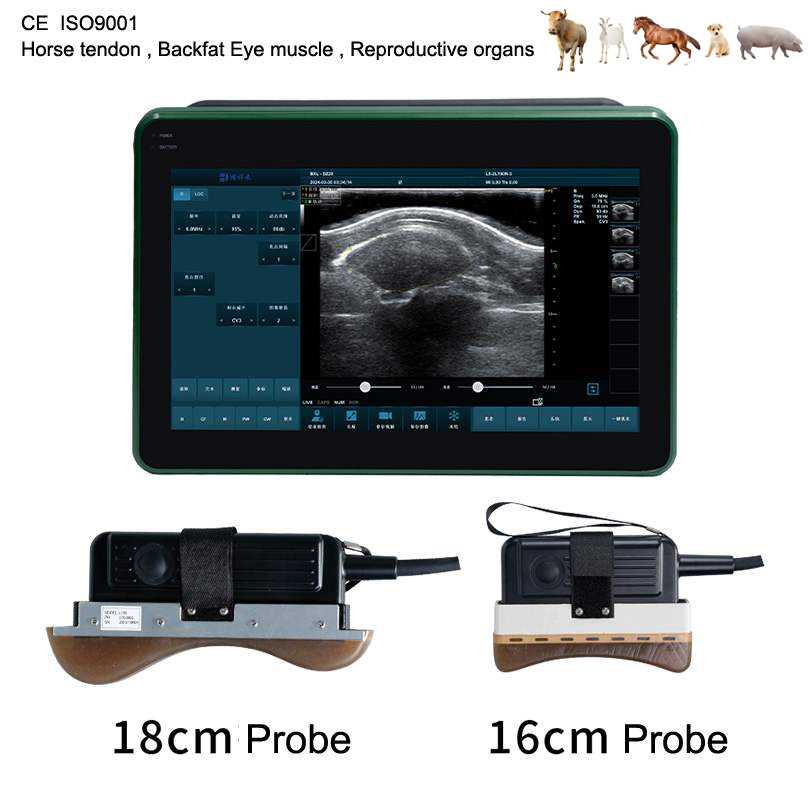Equine Reproductive Ultrasound Machine: Essential Technology for Modern Horse Breeding
Introduction
In today’s equine industry, reproductive efficiency is the key to successful breeding programs. Veterinarians and breeders now rely heavily on equine reproductive ultrasound machines to monitor the reproductive cycle of mares, diagnose pregnancy early, and manage fertility with precision.
With the development of advanced portable veterinary ultrasound systems, equine reproduction has entered a new era of accuracy, safety, and efficiency. For exporters of veterinary imaging products, this field offers tremendous opportunities to serve the global horse breeding market.

What Is an Equine Reproductive Ultrasound Machine?
An equine reproductive ultrasound machine is a specialized veterinary imaging device used to visualize the mare’s reproductive organs — including the ovaries, uterus, and developing fetus — in real time.
It works by emitting high-frequency sound waves through a transducer (probe), which then produces detailed internal images without any invasive procedures or radiation.
Veterinary professionals use this technology to assess the estrous cycle, detect ovulation, confirm pregnancy, and monitor fetal development, making it one of the most valuable tools in equine reproductive medicine.
Key Applications in Equine Reproduction
Early Pregnancy Detection
With modern ultrasound machines, pregnancy can be detected as early as day 14–16 after ovulation. This allows breeders to confirm successful conception quickly and plan future breeding sessions if needed.
Follicle Monitoring and Ovulation Timing
Ultrasound provides clear imaging of ovarian follicles, helping veterinarians determine the optimal time for artificial insemination or natural breeding. Accurate timing improves conception rates and reduces breeding costs.
Monitoring Fetal Health and Growth
Throughout gestation, ultrasound scanning helps check fetal position, heartbeat, and fluid levels, ensuring that the mare and foal remain healthy.
Diagnosis of Reproductive Disorders
It helps detect uterine cysts, infections, or abnormal fluid accumulation that could interfere with conception or gestation.
Guidance for Reproductive Procedures
Ultrasound assists veterinarians during embryo transfer, insemination, or ovarian aspiration, ensuring precision and safety.
Features of a Professional Equine Reproductive Ultrasound Machine
To achieve reliable diagnostic results, an equine reproductive ultrasound system should include the following features:
High-Resolution Imaging – Clear visualization of ovarian structures, follicles, and embryos even at early stages.
Rectal Linear Probe – Specialized probe design for equine reproductive scanning, offering deep penetration and high detail.
Portable and Lightweight – Ideal for field veterinarians who travel to stables or breeding centers.
Durable and Waterproof Housing – Ensures performance in outdoor and farm environments.
Long Battery Life – Continuous operation for 6–8 hours to support full-day work.
Data Storage and Connectivity – USB or wireless export of ultrasound images for records, telemedicine, or research analysis.
User-Friendly Interface – Easy menu navigation, fast startup, and adjustable imaging parameters for veterinarians of all experience levels.
Benefits of Using Equine Reproductive Ultrasound
Improved Breeding Efficiency: Optimizing insemination timing reduces the number of unsuccessful breeding cycles.
Reduced Costs: Early pregnancy detection helps eliminate unnecessary treatments and saves time.
Better Animal Welfare: Non-invasive, painless, and stress-free for mares during examination.
Accurate Reproductive Management: Real-time imaging allows veterinarians to make informed decisions immediately.
Long-Term Productivity: Regular reproductive monitoring ensures better herd fertility and overall farm profitability.
Portable Equine Reproductive Ultrasound for Field Work
For mobile veterinarians, portable equine reproductive ultrasound machines are especially valuable.
These handheld or laptop-style systems are designed for outdoor use — compact, waterproof, and capable of producing high-definition (HD) images directly on screen or via wireless display on tablets.
Some advanced models even support cloud storage, remote diagnosis, and AI-assisted follicle measurement, providing an intelligent solution for equine reproductive management.
Such equipment is widely used in horse farms, equestrian centers, veterinary clinics, and research institutes worldwide.
Global Market and Export Opportunities
The demand for equine reproductive ultrasound machines is rising in major horse-breeding regions such as the United States, Europe, Úc, the Middle East, and South America.
These markets value durable, high-quality imaging products that offer affordable pricing, multilingual software, and technical support.
For exporters and manufacturers in China and other production hubs, offering OEM/ODM customization, after-sales training, and local distribution partnerships can significantly enhance global competitiveness.
High-performance veterinary ultrasound products that combine HD imaging, reliability, and portability are now a key growth segment in the international animal health market.
How to Choose the Right Equine Reproductive Ultrasound Machine
When selecting the best ultrasound equipment for horses, consider the following factors:
Intended Use: Breeding, pregnancy diagnosis, or tendon scanning.
Probe Type: Linear rectal probes for reproduction; convex probes for abdominal or general scanning.
Imaging Quality: Resolution, frame rate, and depth penetration.
Portability: Handheld or laptop design depending on work environment.
Software and Connectivity: Easy data management and report generation.
Service and Warranty: Reliable technical support and maintenance from the supplier.
Choosing the right system ensures long-term stability and accurate reproductive monitoring across breeding seasons.
Kết thúc
The equine reproductive ultrasound machine has revolutionized horse breeding management by providing veterinarians and breeders with accurate, non-invasive diagnostic insight.
Its ability to detect pregnancy early, monitor ovulation, and assess fetal health makes it an indispensable tool in every equine breeding program.
For exporters and veterinary equipment suppliers, investing in innovative, portable, and high-definition ultrasound systems represents a promising opportunity to meet global demand and support sustainable animal reproduction.